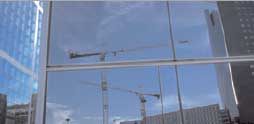|
| Front page | | Contents | | Previous | | Next |
Adapting to the Climate of the Future
Example 4 The Copenhagen Metro and other infrastructure
A flooded metro is one of the worst situations that planners and people responsible for the daily management of the Copenhagen Metro can imagine. It is no wonder that the risk of
heavy rain or storm surges – with or without climate change – was considered when the metro was built.
Such events are rare, but still not quite improbable for people working with infrastructure that are supposed to operate for a hundred years or more. Few of us can imagine a storm surge
in the Copenhagen area, but nevertheless it can happen, most recently it happened in 1825 and 1872.
Beside the general risk, the consulting engineers dealing with this matter have considered the extra risk implied in future changes of the climate in Denmark.
The entrepreneur and the engineers have made sure that all entrance plateaus and descents are elevated to prevent them from being flooded, even at the worst of storms – not even in a
hundred years, when the water level in the Sound may have risen by about 0.50 m above today's level. Fortunately, the surface of the ground is also rising, so that we will probably only see the water rise 30-40 cm. The Metro company has made an agreement with the Copenhagen Road Directorate that the level of adjacent roads will not be raised in
connection with the establishment or renewal of roads, because the measures taken to protect the Metro would otherwise be inefficient.
Action along these lines has also been taken for the Great Belt Tunnel, at the ramps at Sprogø and Halskov.
Large infrastructure is often planned with a time horizon of more than 100 years, and therefore possible water-level rises should also be considered.
The measures have added to the costs, but have been less costly than would have been the case if entrance plateaus and descents had to be rebuilt later.
Also roads and railways are to some extent dependent on the climate. The time horizon of changes is, however, so wide that specific adaptation measures can be taken on a current
basis. Special attention should, however, be given to road and railway infrastructure in coastal areas.
Climate considerations and new buildings
In general, climate issues must be considered when planning new buildings. There is nothing new in that. Also in the past, considerations for the fairly rough Danish climate have focussed
on wind, rain, subzero degrees, snow, insulation etc. What is new is that the climate does not remain the same. For instance increasing wind can put more pressure on roofs and
facades on i.a. single-family houses. Also light glass facades should be strengthened or replaced by facades with small window panes.
Building regulations set out standard requirements for construction work, focusing on new buildings and major rebuilding.
The regulations are administered by the municipal authorities, and the competent authorities should integrate climate change in future revisions of the building regulations.
In coastal areas with low-lying houses, the sea-level rise can cause problems relating to buoyancy and stability. It may be necessary to change the building regulations accordingly, and
for instance prohibit building in exposed areas.

Building with large windows
Houses can be built with windows acting as photo-cells, generating power from solar radiation.
The price of insurance will increase
Insurance companies will have to consider the risk of changes in the frequency of extreme weather incidents, for instance storm surge, heavy rain, hailstorm, or "the storm of the
century", like the one that hit Denmark on 3 December 1999. The losses caused by natural catastrophes, often resulting from extreme weather conditions, have been increasing, and if
the trend continues, this will affect the price of insurance. No matter whether it is the worse weather conditions, or the greater possible losses of value, the result is the same: vulnerability
increases.
Annual damage caused by natural catastrophes
The figure shows the economic and insured losses – adjusted to present values. The trend curves verify the increase in catastrophe losses since 1950.

Source: Munich Re TOPICS geo 2003
Heating or cooling
The total building space in Denmark is about 600 mio. square metres, and new buildings, with floorage reaching about nine mio. square metres, are constructed every year. Assuming a
typical lifetime of 100 years or more, the buildings will have to face a changed climate.
The building technology is expected to develop, introducing new materials and ways of construction, for instance window panes that act as photo voltaic cells. Annual costs of heating
are approx. euro 800 mio. Other things being equal, in 2100 we might save about 25 per cent of this amount as a result of higher outdoor temperatures. On the other hand air
conditioning may be required.
From the point of view of the environment it would, however, be better if a more pleasant indoor climate could be achieved by new construction methods – also on hot days without use
of energy.
| Front page | | Contents | | Previous | | Next | | Top |
Version 1.0 December 2004, © Danish Environmental Protection Agency
|